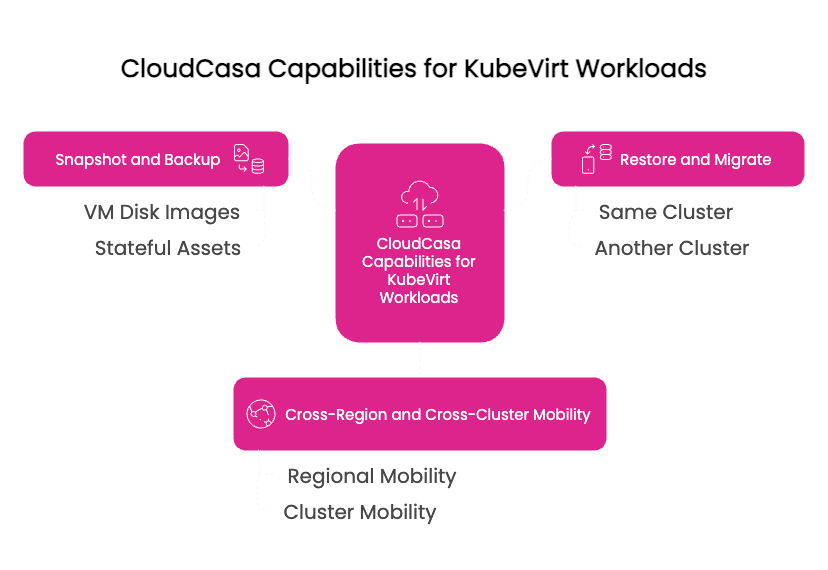Kubernetes has become the foundation for modern applications—but with great flexibility comes greater complexity and risk. Whether it’s an accidental misconfiguration, a failed update, or a cluster-wide outage, disruptions happen fast—and when they do, they impact both your containers and the virtual machines (VMs) running alongside them. In these high-stakes moments, your recovery plan is what makes the difference between a brief hiccup and a full-blown disaster. That’s why having a purpose-built backup solution isn’t just nice to have—it’s essential. In this post, we’ll explore why backing up Kubernetes clusters and VMs is critical, and how Spectro Cloud’s Palette VMO combined with CloudCasa delivers the protection you need, without the complexity.
Why IaC Alone Isn’t a Backup Strategy
A lot of teams rely on Infrastructure-as-Code (IaC) to spin up clusters quickly. It’s great for provisioning nodes, applying manifests, and deploying applications. But here’s the problem: IaC won’t bring back your data.
Even in environments designed to be ephemeral, there’s almost always something stateful in the mix—think:
- Databases running in persistent volumes
- Secrets or config maps created on the fly
- Application-specific annotations or runtime-generated labels
- Integrations with queues, auth systems, and third-party APIs
Rebuilding a cluster with IaC gets you the scaffolding. But without backup, you’re left trying to piece together runtime state manually. And in a high-pressure outage, that’s just not going to cut it.
Hybrid Workloads Make This Even Trickier
If you’re using Spectro Cloud’s Palette VMO, you’re running not just containers, but virtual machines inside your Kubernetes environment. Powered by KubeVirt, Palette VMO makes it easy to manage VMs as first-class citizens right alongside your pods.
This setup is ideal for organizations with a mix of cloud-native services and legacy apps. You can modernize gradually, without needing to forklift everything into containers all at once.
But adding VMs to your Kubernetes stack introduces more complexity when it comes to backup. You’re now responsible for both:
- The Kubernetes control plane and its resources
- The full disk state of virtual machines, often with sensitive, irreplaceable data
That means your backup solution has to handle both worlds—seamlessly.
Palette VMO Makes It Easier, But You Still Need to Back It Up
Palette simplifies VM orchestration. Through its UI, you can configure clusters, assign resources, and deploy workloads—whether they’re pods or VMs. You can even configure cluster-wide backups to capture the state of your Kubernetes environment.
But what about VM disk backups? Persistent volume snapshots? Disaster recovery across regions or clusters? That’s where a dedicated Kubernetes-native backup solution comes into play.
This Is Where CloudCasa Comes In
CloudCasa is purpose-built for Kubernetes—especially for complex, mixed environments like those managed by Palette VMO. It delivers backup and recovery that works for both containerized applications and the VMs you’re running alongside them.
Kubernetes and VM Backups That Actually Work
CloudCasa supports full-cluster backups or targeted protection for specific namespaces, applications, or even individual virtual machines. When selecting a VM, all associated Kubernetes resources—like persistent volumes, secrets, and config maps—are automatically included to ensure application-consistent recovery.
It coordinates volume snapshots alongside Kubernetes objects, so when you restore, your workloads come back fully operational, not just “technically running.”
VM Awareness for KubeVirt
Running VMs inside Kubernetes? No problem.
CloudCasa detects KubeVirt workloads automatically and treats them like the stateful assets they are. It can:
- Snapshot and back up VM disk images
- Restore VMs into the same cluster or migrate them to another
- Support cross-region and cross-cluster VM mobility

All of this is managed through a clean, centralized UI with built-in access controls, backup policies, and reporting for compliance purposes.
Built-In Immutability for Peace of Mind
Backups are only useful if you can trust them. CloudCasa supports immutable backups, ensuring that once a backup is written, it cannot be modified or deleted—accidentally or maliciously.
This protects against ransomware, insider threats, and accidental deletion—while helping meet compliance requirements and security standards.
Simple Setup, Flexible Deployment
Forget the complexity of building and maintaining a backup platform yourself.
CloudCasa gives you the flexibility to deploy how you need:
- Use the fully managed SaaS control plane for fast onboarding and minimal overhead
- Or choose the self-hosted option for air-gapped environments, custom integrations, or when data residency matters
You also get:
- Native support for all major cloud storage providers
- Secure credential handling and encrypted backup data
- Built-in role-based access controls
- Comprehensive reporting for compliance purposes
It’s backup that works out of the box—and scales with you, whether you’re in the cloud, on-prem, or at the edge.
Building a Smarter Backup Strategy
Here’s what a solid backup strategy looks like when you’re running Kubernetes and VMs:
- Schedule full cluster backups at consistent intervals
- Use namespace- or workload-based backups for added flexibility
- Store backups in multiple locations to ensure resiliency
- Test restores regularly to validate recovery procedures
With CloudCasa and Palette VMO working together, backup and recovery become part of your day-to-day operations—reliable, predictable, and ready for production.
Final Thoughts
You can’t predict every outage, API misfire, or fat-fingered delete. But you can prepare for them.
If you’re running modern Kubernetes environments—especially with VMs in the mix—backups aren’t optional. They’re part of your infrastructure strategy.
Spectro Cloud’s Palette VMO gives you control over hybrid workloads. CloudCasa gives you the power to protect them.
Ready to back it all up—Kubernetes, VMs, and everything in between?